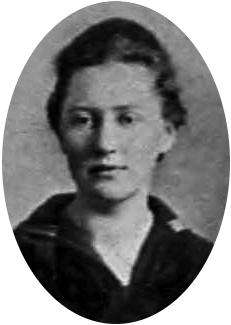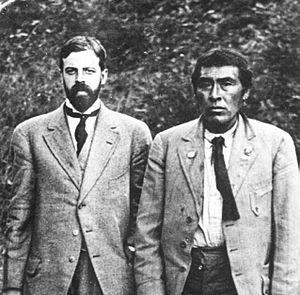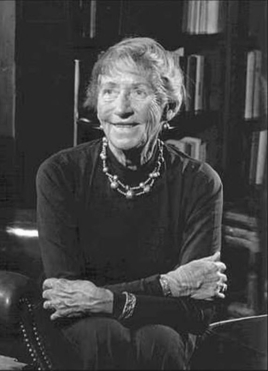Theodora Kroeber facts for kids
Quick facts for kids
Theodora Kroeber
|
|
|---|---|

Kroeber in 1919
|
|
| Born |
Theodora Covel Kracaw
March 24, 1897 Denver, Colorado, U.S.
|
| Died | July 4, 1979 (aged 82) Berkeley, California, U.S.
|
| Alma mater | University of California, Berkeley |
| Occupation |
|
| Spouse(s) |
Clifton Brown
(m. 1920; died 1923)John Quinn
(m. 1969) |
| Children | 4, including Karl and Ursula |
Theodora Kroeber (pronounced KROH-ber; born Theodora Covel Kracaw; March 24, 1897 – July 4, 1979) was an American writer and anthropologist. She is best known for her books about the Native Californian cultures. Theodora grew up in Telluride, Colorado, and later studied at the University of California, Berkeley.
After her first husband passed away, she began studying anthropology. There, she met and married the famous anthropologist Alfred Kroeber. One of their children was the well-known writer Ursula K. Le Guin. Theodora started writing professionally later in life. Her most famous book, Ishi in Two Worlds, tells the story of Ishi, the last member of the Yahi people.
Contents
Theodora's Early Life and Education
Theodora Covel Kracaw was born on March 24, 1897, in Denver, Colorado. She spent her childhood in the mining town of Telluride, Colorado, where her parents owned a store. Theodora was the youngest of three children and described her childhood as happy. She graduated from Telluride High School in 1915 as the top student.
After high school, Theodora moved to California and started college at the University of California, Berkeley in 1915. She first thought about studying economics or English but chose psychology. She earned her bachelor's degree in psychology in 1919 and then a master's degree in clinical psychology in 1920.
First Marriage and New Interests
In the summer of 1920, Theodora married Clifton Spencer Brown, a law student. They had two sons, Clifton II and Theodore. Sadly, Clifton passed away in 1923. Theodora and her children moved back to Berkeley. While living in Santa Fe, New Mexico, she had become interested in Native American art and culture. This led her to decide to study anthropology at UC Berkeley.
Studying Anthropology and Second Marriage
Theodora returned to the university in 1924 to study anthropology. She met Alfred Kroeber, who was a leading anthropologist and head of the anthropology department. Theodora and Alfred married on March 26, 1926. Alfred adopted Theodora's two sons. They also had two more children together: Karl and Ursula. All four children later became professors or famous writers.
In 1926, the Kroebers traveled to Peru for an archaeological dig. It was Theodora's first time at such a site, and she helped identify and organize ancient items. She also published her first academic paper that year. Although Alfred encouraged her to continue her studies, Theodora decided not to, feeling she had many family responsibilities.
The Kroebers spent most of their time in a large redwood house in Berkeley. They also had a farmhouse in the Napa Valley where Alfred's Native American friends often visited. Theodora kept in touch with Alfred's academic friends by hosting them at their home.
Theodora's Writing Career
Theodora began writing seriously after her children grew up and her husband retired. In 1959, when she was 62, she published The Inland Whale. This book was a collection of Native Californian legends that she retold in her own style. The book was well-received, with critics praising how she made the legends easy for everyone to read.
The Story of Ishi
Theodora spent time researching and writing about Ishi, who was believed to be the last member of the Yahi people. Ishi was found in 1911 and became friends with Alfred Kroeber and his colleagues at UC Berkeley. Ishi passed away in 1916. Theodora felt it was important to tell his story, so she wrote Ishi in Two Worlds, which was published in 1961, after Alfred's death.
Writing this book was challenging for Theodora because it described the difficult experiences of the Yahi people. In 1964, she released a version for children called Ishi: Last of His Tribe. This version explained the cultural differences that happened as the United States expanded.
Ishi in Two Worlds became very popular. It was translated into many languages and sold over a million copies. Many people praised the book for its moving story and for making readers feel connected to Ishi's life. It was even made into a television film in 1978.
Later, some people had mixed feelings about the book. They noted that while it showed the hardships faced by the Yahi, it didn't always question how Ishi was treated. However, many still admired Theodora's writing style. Historian Douglas Sackman compared Ishi in Two Worlds to To Kill a Mockingbird because both books explored difficult parts of American history and society.
Other Writings
Theodora also worked on other books. She edited some of Alfred's writings and wrote introductions for others. She also wrote a biography of her husband called Alfred Kroeber: A Personal Configuration, published in 1970. Reviewers praised this book for its beautiful writing and for showing Alfred's life and work.
She also collaborated with anthropologist Robert Heizer on two books with pictures about Native Americans in California: Almost Ancestors (1968) and Drawn from Life (1976). These books combined images with Theodora's text, showing the changes among California's Native American communities.
Later Life and Legacy
In 1969, Theodora married John Quinn, an artist and psychotherapist who was younger than her. They lived in Berkeley and also designed a home in Anchor Bay, California. John encouraged her to finish her biography of Alfred.
Theodora was a supporter of the Democratic Party and participated in peace rallies in her later years. In 1977, she became a regent of the University of California board. She resigned after a year, finding the position tiring. Her last act was to challenge the university's involvement in nuclear weapons research. Theodora Kroeber passed away from cancer on July 4, 1979, in her Berkeley home.
Theodora Kroeber's writing had a lasting impact. Her book The Inland Whale helped people see Native American oral traditions as important literature. Many people believe that Ishi in Two Worlds brought Ishi's story to a much wider audience. Her work also influenced her daughter, Ursula K. Le Guin, whose stories often explore different cultures. Theodora Kroeber is remembered for her great skill in explaining one culture to another through her writing.
Selected Works
- The Inland Whale. 1959. Indiana University Press, Bloomington.
- Ishi in Two Worlds: a biography of the last wild Indian in North America. 1961. Berkley Books.
- Ishi, Last of His Tribe. Illus. Ruth Robbins. 1964. Parnassus Press, Berkeley, California.
- Almost Ancestors: The First Californians. Kroeber and Robert F. Heizer. 1968. Sierra Club Books, San Francisco.
- Alfred Kroeber: A Personal Configuration. 1970. University of California Press, Berkeley.
- Drawn from Life: California Indians in Pen and Brush. Compiled by Kroeber, Robert F. Heizer and Albert B. Elsasser. 1976. Ballena Press, Socorro, New Mexico.
- Ishi, the Last Yahi: A Documentary History. Kroeber and Robert F. Heizer. 1979. University of California Press, Berkeley.
See also
 In Spanish: Theodora Kroeber para niños
In Spanish: Theodora Kroeber para niños



